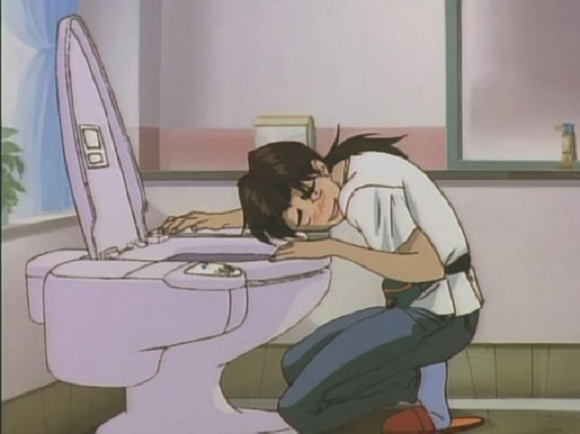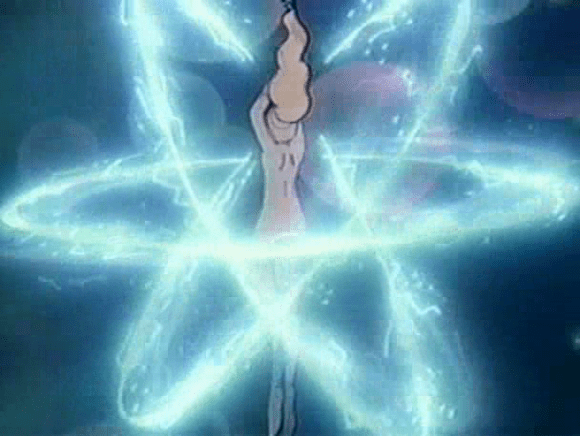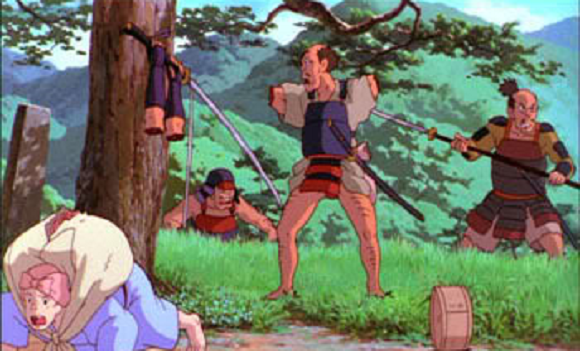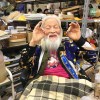With Japan’s relatively lenient attitudes towards sex and violence in cartoons, you might get the impression that the whole society has come to a consensus that anime artists can draw whatever they like. That’s not always the case, though, and in recent years a string of crimes committed by individuals with an obsessive love for animation and comics has rekindled the debate about how much, if any, legal control should be placed on anime content.
It’s no shock that a former manga artist and adult video director has spoken out in opposition to such regulation. What is surprising, though, is his pick for the creator of the most detrimental anime: Studio Ghibli co-founder Hayao Miyazaki.
Tatsuya Egawa has worn many different hats in his life. After a brief stint as a college math professor, Egawa became a full-time manga artist, penning manic and risqué comedies such as Be Free and Tokyo Daigaku Monogatari. He’s best known among English-speaking fans for Golden Boy, which was adapted into a six-part anime in the ‘90s and follows the adventures of wandering pervert savant Kintaro Oe.
▼ Seen here becoming sexually aroused while cleaning his female boss’ toilet.
Egawa later went on to direct porno films with real, human actors, and has recently served as director for a few general release, non-X-rated movies, including a live-action version of his own Tokyo Daigaku Monogatari.
On September 1, the multi-talented Egawa appeared on TV personality Beat Takeshi’s TV Tackle program to participate in a debate over whether or not provocative anime provokes actual crimes. Taking the position that it very much does was criminal psychologist Yasuyuki Deguchi, who argued that, “For people with a distorted way of thinking, the fact of the matter is that anime is a big trigger [for them to commit crimes].”
Egawa quickly took issue with this, pointing out that, “Not everyone who watches anime commits crimes.” Although he acknowledged that anime can have an influence on those watching it, he asserted that the problem is not adult content itself. Rather, it’s a lack of awareness and self-recognition.
“Kids have a natural desire to see erotic things,” he began. “Trying to suppress that is wrong.” To Egawa, presenting sexual material as being sexual is fine, as long as the anime is aware of and recognizes what it’s doing.
For example, Egawa sees no harm in anime’s frequent magical transformation sequences that show its female characters in the nude. “That’s fine. You can clearly understand that it’s saying, ‘Hey, check this out! She’s naked!’”
▼ Lightning doesn’t count as clothes.
In response to Egawa’s assertion that both good and bad anime exist, one of the other guests asked him for an example of the latter, to which he unexpectedly offered up what’s often considered to be the gold standard of purity in anime, the films of Hayao Miyazaki.
“I think Miyazaki’s anime are the worst. To the untrained eye, it’s not noticeable…but Miyazaki’s works, which craftily conceal sex and violence, are bad anime.”
Just to be clear that he wasn’t merely stating a personal dislike for the anime legend’s works, he lumped them in with anime that hide such things unconsciously, condemning such anime as being “the most dangerous.”
Egawa didn’t go into greater specifics on his criticisms of Miyazaki’s films, nor did he specify whether or not he felt the Studio Ghibli projects helmed by other directors were also guilty of such things.
▼ More details would have been nice, since we’re not sure how this sequence from Princess Mononoke qualifies as “craftily concealing violence.”
Egawa’s vague remarks have been stirring up debate in anime and media circles in Japan, so hopefully he’ll take it upon himself to clarify and expand on them. We’d be curious to hear more, since we still can’t bring ourselves to believe that kids’ favorite Totoro is dangerous (his giant teeth notwithstanding).
Sources: Livedoor News, Yahoo! News Japan
Insert images: Craig Lotter, Tumbler, Photobucket




 List of anime directors fans expect the most from topped by….Goro Miyazaki?!
List of anime directors fans expect the most from topped by….Goro Miyazaki?! Hayao Miyazaki reveals the kind of otaku he hates the most
Hayao Miyazaki reveals the kind of otaku he hates the most Ghibli reveals genre of Hayao Miyazaki’s next anime, and that it’s also working on new CG film
Ghibli reveals genre of Hayao Miyazaki’s next anime, and that it’s also working on new CG film Totoro made me do it! Man says he was inspired to shoplift by Studio Ghibli anime classic
Totoro made me do it! Man says he was inspired to shoplift by Studio Ghibli anime classic Anime critic thinks Miyazaki may be unable to fill Ghibli talent void quickly enough for new film
Anime critic thinks Miyazaki may be unable to fill Ghibli talent void quickly enough for new film We revisited Sweets Paradise after a decade to see if Japan’s dessert buffet still delivers
We revisited Sweets Paradise after a decade to see if Japan’s dessert buffet still delivers That time Seiji called JASRAC to ask why he didn’t get paid royalties for his song being on TV
That time Seiji called JASRAC to ask why he didn’t get paid royalties for his song being on TV Cup Noodle tries an authentic Jiro-style ramen, but something’s not quite right
Cup Noodle tries an authentic Jiro-style ramen, but something’s not quite right 7 great places to see Mt. Fuji from without having to climb it
7 great places to see Mt. Fuji from without having to climb it McDonald’s Japan has free smiles on its delivery menu, but does asking for one make a difference?
McDonald’s Japan has free smiles on its delivery menu, but does asking for one make a difference? In downtown Tokyo, we talk to a guy who says he’s from Orion’s belt, get called an “idiot”
In downtown Tokyo, we talk to a guy who says he’s from Orion’s belt, get called an “idiot” Pizza Hut Japan’s hot lucky bags are perfect for a New Year’s pizza party
Pizza Hut Japan’s hot lucky bags are perfect for a New Year’s pizza party Japanese gamer furniture company creates cabinets just for collectible trading card gamers【Pics】
Japanese gamer furniture company creates cabinets just for collectible trading card gamers【Pics】 More than one in three Japanese working women in survey would rather be housewives
More than one in three Japanese working women in survey would rather be housewives Eat Kuroge Wagyu beef at this Japanese restaurant in Ginza for less than 10 bucks!
Eat Kuroge Wagyu beef at this Japanese restaurant in Ginza for less than 10 bucks! Starbucks Japan ready to get Year of the Horse started with adorable drinkware and plushies【Pics】
Starbucks Japan ready to get Year of the Horse started with adorable drinkware and plushies【Pics】 Cyberpunk anime meets traditional culture in Ghost in the Shell gold leaf Japanese changing screens
Cyberpunk anime meets traditional culture in Ghost in the Shell gold leaf Japanese changing screens Hello Kitty Choco Egg figures are an adorable trip through three periods of Japanese pop culture【Pics】
Hello Kitty Choco Egg figures are an adorable trip through three periods of Japanese pop culture【Pics】 7-Eleven Japan’s ramen-cooking robot whipped us up a bowl of noodles【Taste test】
7-Eleven Japan’s ramen-cooking robot whipped us up a bowl of noodles【Taste test】 We found possibly the quietest Japanese-style hotel in Tokyo’s bustling Shinjuku district
We found possibly the quietest Japanese-style hotel in Tokyo’s bustling Shinjuku district Japan’s otoshidama tradition of giving kids money at New Year’s gets a social welfare upgrade
Japan’s otoshidama tradition of giving kids money at New Year’s gets a social welfare upgrade Sumo Sanrio! Hello Kitty and pals team up with Japan Sumo Association for new merch【Pics】
Sumo Sanrio! Hello Kitty and pals team up with Japan Sumo Association for new merch【Pics】 More Than a Capsule Stay: Why Solo Travelers Choose “global cabin Yokohama Chinatown”
More Than a Capsule Stay: Why Solo Travelers Choose “global cabin Yokohama Chinatown” Japan’s oldest largetooth sawfish in captivity back on display in Mie Prefecture
Japan’s oldest largetooth sawfish in captivity back on display in Mie Prefecture 7-Eleven Japan starts new temporary luggage storage service in over 300 branches
7-Eleven Japan starts new temporary luggage storage service in over 300 branches Disillusionment at Tsukiji’s tourist-target prices led us to a great ramen restaurant in Tokyo
Disillusionment at Tsukiji’s tourist-target prices led us to a great ramen restaurant in Tokyo Starbucks teams up with 166-year-old Kyoto doll maker for Year of the Horse decorations【Photos】
Starbucks teams up with 166-year-old Kyoto doll maker for Year of the Horse decorations【Photos】 Tokyo considering law requiring more trash cans following litter increase in heavily touristed area
Tokyo considering law requiring more trash cans following litter increase in heavily touristed area Tokyo’s Tsukiji sushi neighborhood asks tour groups to stay away for the rest of the month
Tokyo’s Tsukiji sushi neighborhood asks tour groups to stay away for the rest of the month Tokyo event lets you travel back in time, for free, to celebrate 100 years since Showa era start
Tokyo event lets you travel back in time, for free, to celebrate 100 years since Showa era start Sanrio theme park in Japan announces plans to expand into a Sanrio resort
Sanrio theme park in Japan announces plans to expand into a Sanrio resort Japan may add Japanese language proficiency, lifestyle classes to permanent foreign resident requirements
Japan may add Japanese language proficiency, lifestyle classes to permanent foreign resident requirements Stamina-destroying “Paralysis Noodles” are Tokyo’s newest over-the-top ramen innovation
Stamina-destroying “Paralysis Noodles” are Tokyo’s newest over-the-top ramen innovation Survey asks foreign tourists what bothered them in Japan, more than half gave same answer
Survey asks foreign tourists what bothered them in Japan, more than half gave same answer Japan’s human washing machines will go on sale to general public, demos to be held in Tokyo
Japan’s human washing machines will go on sale to general public, demos to be held in Tokyo Japan’s deadliest food claims more victims, but why do people keep eating it for New Year’s?
Japan’s deadliest food claims more victims, but why do people keep eating it for New Year’s? We deeply regret going into this tunnel on our walk in the mountains of Japan
We deeply regret going into this tunnel on our walk in the mountains of Japan Studio Ghibli releases Kodama forest spirits from Princess Mononoke to light up your home
Studio Ghibli releases Kodama forest spirits from Princess Mononoke to light up your home Major Japanese hotel chain says reservations via overseas booking sites may not be valid
Major Japanese hotel chain says reservations via overseas booking sites may not be valid Put sesame oil in your coffee? Japanese maker says it’s the best way to start your day【Taste test】
Put sesame oil in your coffee? Japanese maker says it’s the best way to start your day【Taste test】 No more using real katana for tourism activities, Japan’s National Police Agency says
No more using real katana for tourism activities, Japan’s National Police Agency says Starbucks Japan reveals new sakura drinkware collection, inspired by evening cherry blossoms
Starbucks Japan reveals new sakura drinkware collection, inspired by evening cherry blossoms Updated cherry blossom forecast shows extra-long sakura season for Japan this year
Updated cherry blossom forecast shows extra-long sakura season for Japan this year Hayao Miyazaki working on new project, says “I’m going to continue making anime until I die”
Hayao Miyazaki working on new project, says “I’m going to continue making anime until I die” Hayao Miyazaki’s The Wind Rises manga to be published in collected form for the first time
Hayao Miyazaki’s The Wind Rises manga to be published in collected form for the first time Hayao Miyazaki’s latest comeback is so that he can leave an anime behind for his grandson
Hayao Miyazaki’s latest comeback is so that he can leave an anime behind for his grandson Hayao Miyazaki based one of Studio Ghibli’s most memorable anime characters on his own mom
Hayao Miyazaki based one of Studio Ghibli’s most memorable anime characters on his own mom Evangelion creator says even Hayao Miyazaki anime don’t have enough Miyazaki
Evangelion creator says even Hayao Miyazaki anime don’t have enough Miyazaki Video documentary explores the Essence of Humanity in the film works of Hayao Miyazaki【Video】
Video documentary explores the Essence of Humanity in the film works of Hayao Miyazaki【Video】 Studio Ghibli’s Hayao Miyazaki to retire from filmmaking
Studio Ghibli’s Hayao Miyazaki to retire from filmmaking Hayao Miyazaki slams anime, hints at comeback, and praises The Red Turtle, all in one breath
Hayao Miyazaki slams anime, hints at comeback, and praises The Red Turtle, all in one breath Hayao Miyazaki and Evangelion creator get together for a photo and a talk about beards
Hayao Miyazaki and Evangelion creator get together for a photo and a talk about beards Ghibli’s Hayao Miyazaki says the anime industry’s problem is that it’s full of anime fans
Ghibli’s Hayao Miyazaki says the anime industry’s problem is that it’s full of anime fans Hayao Miyazaki is getting worried about how his new anime is being marketed, Ghibli producer says
Hayao Miyazaki is getting worried about how his new anime is being marketed, Ghibli producer says New Hayao Miyazaki anime for Tokyo’s Ghibli Museum has spring debut date announced
New Hayao Miyazaki anime for Tokyo’s Ghibli Museum has spring debut date announced Hayao Miyazaki talks on how working hard isn’t something to be proud of, not forgiving yourself
Hayao Miyazaki talks on how working hard isn’t something to be proud of, not forgiving yourself
Leave a Reply